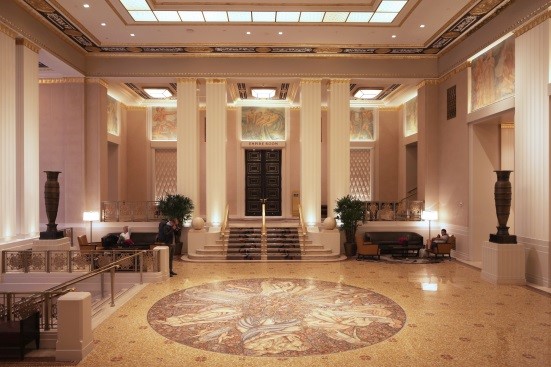
 Landmarks Preservation Commission311
Landmarks Preservation Commission311 Search all NYC.gov websites
Search all NYC.gov websites
FOR IMMEDIATE RELEASE:
Tuesday, March 7, 2017
LANDMARKS COMMISSION PROTECTS ICONIC INTERIOR SPACES OF THE WALDORF-ASTORIA HOTEL
LPC Designates Hotel's Most Celebrated Spaces, Including the Park Avenue Lobby, Grand Ballroom and Silver Gallery
(New York, NY)- The New York City Landmarks Preservation Commission today unanimously voted to landmark several interior spaces of the Waldorf-Astoria Hotel in Manhattan. Considered one of New York City's most prominent and culturally significant hotels, the Waldorf-Astoria was designed by Schultze and Weaver and opened in September 1931. The hotel's exterior became a New York City landmark in 1993. Today's vote will protect the building's most lavish public spaces, including interconnected rooms and corridors on the ground, first, second and third floors. The designation brings the number of New York City Interior Landmarks to 119.
"The Waldorf Astoria Hotel has some of the most internationally renowned rooms in all of New York City," said Commission Chair Meenakshi Srinivasan. "These designated spaces connect seamlessly from the foyers and lobbies on the ground and first floor to the Grand Ballroom and other public rooms on the third floor. Today's action not only protects the rich and beautifully detailed art-deco features of the hotel's interior public spaces, it also preserves the unique experience of moving through the hotel's varied interiors, which countless New Yorkers and visitors have enjoyed for more than eight decades."

Designated spaces on the first floor include the lofty Park Avenue Lobby (at left), an entry hall with 13 murals and an immense floor mosaic by the French artist Louis Rigal, and the elegant wood-paneled Main Lobby, featuring black marble pillars and ceiling reliefs. On the east end of the first floor, near Lexington Avenue, are elevators with distinctive metal doors and double staircases with "frozen fountain" balustrades leading through the first, second and third floors.
On the third floor, designated spaces include the glittering Silver Gallery, a long mirrored hallway with a black-and-white mosaic floor that links four ballrooms. The Silver Gallery has a coved ceiling that incorporates 12 murals by the American artist Edward Emerson Simmons. The murals, which depict the months of the year, are among the only features salvaged from the hotel's original Fifth Avenue building. The Grand Ballroom, one of the largest event spaces in the New York City, can accommodate as many as 1,550 guests. Arranged on three levels, the space has projecting balconies and an elaborate ceiling relief. This fabled room has hosted countless dinners, banquets, galas and balls, including the annual Alfred E. Smith Dinner, a fundraiser for Catholic charities that attracts major presidential candidates.
Also on the third floor is the Basildon Room, which has colorful wall and ceiling panels acquired from an 18th century British mansion, as well as the more restrained Jade Room and Astor Gallery. While these memorable interiors have had alterations and sometimes exhibit new finishes, most retain their original dimensions and share such unifying elements as gilded plaster reliefs, nickel-bronze metalwork, glazed doors, mirrored walls and various types of exotic wood paneling.
Over the years, the hotel's Art Deco and Modern Classical style motifs create strikingly elegant spaces that have played host to an impressive roster of guests, including numerous political leaders and popular entertainers. The Waldorf-Astoria Hotel is one of two major early 20th-century hotels in New York City that have preserved many of their original public spaces. While the Plaza Hotel, which had its interiors designated in 2005, features Renaissance Revival style decoration, the Waldorf is notable and unique for containing some of the finest and most culturally significant Art Deco interiors in New York City.
###
The Landmarks Preservation Commission is the mayoral agency responsible for protecting and preserving New York City's architecturally, historically and culturally significant buildings and sites. Since its creation in 1965, LPC has granted landmark status to more than 36,000 buildings and sites, including 1398 individual landmarks, 119 interior landmarks, 10 scenic landmarks, and 141 historic districts and extensions in all five boroughs. Under the City's landmarks law, considered among the most powerful in the nation, the Commission must be comprised of at least three architects, a historian, a realtor, a planner or landscape architect, as well as a representative of each borough.


